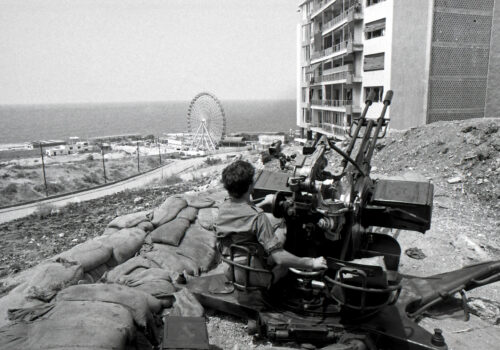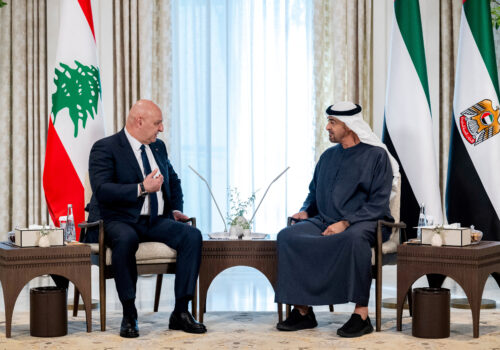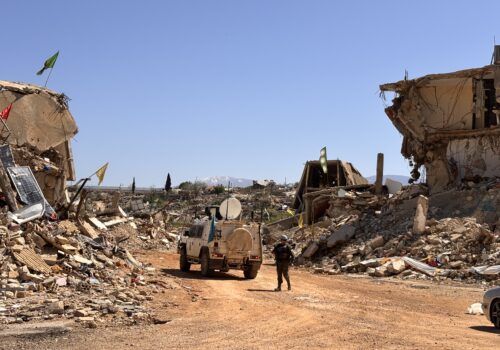What Lebanon’s municipal election results mean for Hezbollah
Lebanon’s political machine is moving again.
In May, the Lebanese concluded country-wide municipal and mayoral elections—their first in nine years—on the heels of Joseph Aoun filling Beirut’s two-year presidential vacancy, and an uncharacteristically speedy appointment of a prime minister and cabinet.
Mere momentum should not be equated with long-term progress towards stabilization, particularly with respect to Hezbollah’s disarmament. The municipal election results did not demonstrate the prominent militant group’s outright dominance over Lebanon’s Shiites. However, Hezbollah nevertheless retains preponderant popularity among them and influence over their electoral and political choices. However, as Hezbollah dubbed them, these elections were a “promotional event” for the real prize: the May 2026 legislative elections. If the group can then expand upon its recent electoral success, and if Aoun’s interminable dialogue with Hezbollah over its arms ever becomes serious, then it can leverage its popular and political weight to steer those discussions toward an outcome allowing it to retain its arms.
Unpacking the results
Hezbollah boasts that its sweep of the municipal and mayoral elections in Beirut, Baalbek-Hermel, and south Lebanon was a virtually unmitigated “tsunami.”
At face value, the group’s claims are true. In south Lebanon’s Nabatieh and South Governorates, Hezbollah’s joint electoral list with the Amal Party, dubbed the “Development and Loyalty” list, ran unconstested and won 109 of 272 municipalities by default. In some municipalities, this victory was due to overwhelming local support for Amal and Hezbollah, and in others, to pressure from those parties forcing opponents to withdraw their candidacy or forgo running altogether.
The Amal-Hezbollah lists also took the overwhelming majority of the remaining municipalities, where the elections came down to a contest, with the exception of a handful of seats. But even there, the self-described Amal-Hezbollah Shiite Duo largely did not lose out to outright ideological opponents, apart from Amal’s loss of two municipal seats in Deir Al Zahrani to the Communist Party. Instead, in many cases, the group lost to familial or clan lists, otherwise seemingly neutral on the question of Hezbollah’s private arsenal.
In the Sidon District’s Zrarieh, for example, Development and Loyalty won only six of the fifteen contested seats against the opposition, development-focused “Build It Together” list. But opposition figure Riad al-Asaad—who has previously bemoaned American-led attempts to weaken Hezbollah as “an Israeli goal” and who backed Build It Together— insisted that “competition [with Hezbollah] isn’t over the choice of resistance, but development.”
These successes replicated earlier wins in the Baalbek-Hermel Governorate, which witnessed significantly higher voter turnout over the last municipal elections in 2016. Here, Development and Loyalty won all eighty municipalities—twenty-eight by default, twenty-nine through electoral contests, and twenty-two where independent pro-Hezbollah lists competed with each other. In many cases here as well, the Amal-Hezbollah list faced off against ostensible independents, but who were nevertheless ideologically aligned with Hezbollah, as in Bednayel, where Development and Loyalty confronted the explicitly pro-Hezbollah “Loyalty to the Resistance” list, or in Brital, where the Hezbollah-Amal backed “Brital Families” list faced openly pro-Hezbollah “Loyalty and Development” list.
For example, Hezbollah-backed candidates swept the municipal council after a hard-fought electoral battle in the city of Baalbek. But voting numbers painted a more complex picture: of 37,142 eligible voters—22,573 of whom are Shiites—a range of 11,674-12,199 voted for Development and Loyalty, while the political opposition list “My City Baalbek” garnered 5,258-5,802 votes. The latter only attracted four hundred to 790 Shiites, compared with 11,290 Shiites for Development and Loyalty, demonstrating the continued loyalty of Hezbollah’s sectarian base. Meanwhile, Hezbollah increased its inroads into Baalbek’s Sunni population, drawing close to 1500 of their votes, and widened its victory margin over My City Baalbek from the 2016 municipal elections.
SIGN UP FOR THIS WEEK IN THE MIDEAST NEWSLETTER
But these results, good as they are, were far from the unmitigated success that Hezbollah’s propaganda organs sought to spin. In a main Hezbollah stronghold like the city of Baalbek, the group should consider its victory margin too close for comfort, especially as voter turnout in the city itself, in sharp contrast to the District and Governorate level, stood at approximately 47.2 percent generally, and 53.51 percent among Shiites specifically. This was higher than 2016’s level of 44 percent turnout of 31,510 eligible voters. However, it was still low considering the group’s great efforts to encourage its base’s participation in an election painted as a referendum on Hezbollah’s arms and existence, occurring at a historical inflection point for Lebanon.
The electoral battles in the more populous South Lebanon and Nabatieh Governorates offered a starker warning to the group. These areas collectively witnessed similarly depressed voting levels—36.94 percent overall (43.17 percent in South Lebanon and 36.65 percent in Nabatieh) compared to 48.15 percent in 2016. Hezbollah’s results were also spottier at face value, with opposing lists, if not outright ideological opponents, making deeper inroads among the electorate despite ultimately failing to unseat the Hezbollah-Amal Duo.
The apathy factor
One plausible explanation is that Hezbollah has lost at least some of its ability to mobilize its loyal masses. This could stem, from, as some have alleged, growing Shiite discontent with the party, particularly over instigating the recent ruinous war with Israel—which could portend a massive backlash against Hezbollah coupled with sizable defections from its base’s ranks. But the materialization of this scenario depends on a complex set of currently absent factors, particularly the existence of a credible and unified Shiite opposition, with the means and ability to deliver on these people’s needs, and thus attract this alleged silent anti-Hezbollah majority.
It is more plausible that the depressed voter turnout had nothing to do with Hezbollah. After all, the silent—and allegedly anti-Hezbollah—majority of Lebanese southerners didn’t go out and vote for the group’s opponents either. They stayed home.
Therefore, rather than a silent vote against Hezbollah, their abstention seems to have stemmed from overall Lebanese political disillusionment and loss of hope in the system’s ability to bring about change, leading to complacency. In September of 2024, for example, Arab Barometer found 76 percent of all Lebanese “uninterested in politics,” while 45 percent described themselves as highly apathetic. Two years prior, 65 percent of Lebanese had even said they didn’t care if their country remained a democracy—more accurately, a procedural democracy—as long as it “can maintain order and stability.”
Political apathy isn’t ideal for Hezbollah. But a Shiite population as politically quiescent and disinterested as the rest of the Lebanese would not undermine the group’s political power, and is thus preferable to an actively hostile one. This, coupled with other factors, like fear of being caught in the midst of Israel’s ongoing military actions that escalated in the days preceding the election, and the difficulty of traveling to south Lebanon for voters displaced by the recent war, could have also impacted voter turnout.
Delayed disarmament
The municipal elections were the last in several significant, post-war milestones during which Hezbollah needed to demonstrate that it remains the primary political and social representative of Lebanese Shiites. But this victory is fragile, delaying, for now, he group’s disarmament, despite the calls for such action gaining increasing momentum. But delaying that prospect does not eliminate it altogether. That specter will continue to haunt Hezbollah unless and until it can expand its municipal election successes come 2026’s parliamentary plebiscite—sweeping all seats it contests while denying Shiite opposition figures any electoral victories, drive up the voting rate among its supporters, and broaden its share of the popular vote. It’s a tall order, but Hezbollah has long proven itself a learning organization, and it will use all the carrots and sticks at its disposal to achieve that result. Here, a combination of delivering on post-war reconstruction of predominantly Shiite areas damaged during the recent war with Israel, while cowing potential opponents with threats, legal action, and actual force, will prove critical to the group’s chances of success.
The question is, will its opponents likewise learn from their mistakes and failure to challenge the group’s Shiite hegemony at a time when they allege its sway over that sect is at its weakest ever—or will they once again rest on the laurels of their empty slogans and symbolic or imaginary triumphs, leaving the “Party of God” to once again be the victors?
David Daoud was a nonresident fellow with the Atlantic Council’s Rafik Hariri Center and Middle East Programs and a research analyst on Hezbollah and Lebanon at United Against Nuclear Iran (UANI).
Further reading
Thu, May 22, 2025
Lebanon’s 1982 war reverberates in Israel’s Syria campaign
MENASource By Sinan Hatahet
Israel's ongoing intervention in Syria appears different from its 1982 invasion of Lebanon—but beneath the surface, parallels are striking.
Mon, May 12, 2025
Landmark UAE visit highlights President Aoun’s catch twenty-two
MENASource By Jean-Loup Samaan
Modest outcomes from the Lebanese president's visit reflects that Abu Dhabi remains cautious towards Beirut.
Tue, Apr 29, 2025
Dispatch from the UN Blue Line: Israel’s ‘systematic destruction’ in Lebanon
MENASource By Nicholas Blanford
If Hezbollah refuses to disarm, Israel would almost certainly escalate its attacks possibly to the extent of resuming the war in Lebanon.
Image: May 24, 2025, Tyre, Tyre, Lebanon: Lebanese women show their stained thumbs after casting their votes during the countryââ¬â¢s last phase of municipal elections in the southern port city of Tyre. Residents of southern Lebanon headed to vote in election that will test support for Hezbollah in the predominantly Shiite areas, months after the end of the destructive Israel-Hezbollah war. Hezbollah and Amal of Parliament Speaker Nabih Berri and both are expected to win mayoral races and the majority of seats in municipal councils. Both groups already won many municipalities uncontested. (Credit Image: © Marwan Naamani/ZUMA Press Wire)



